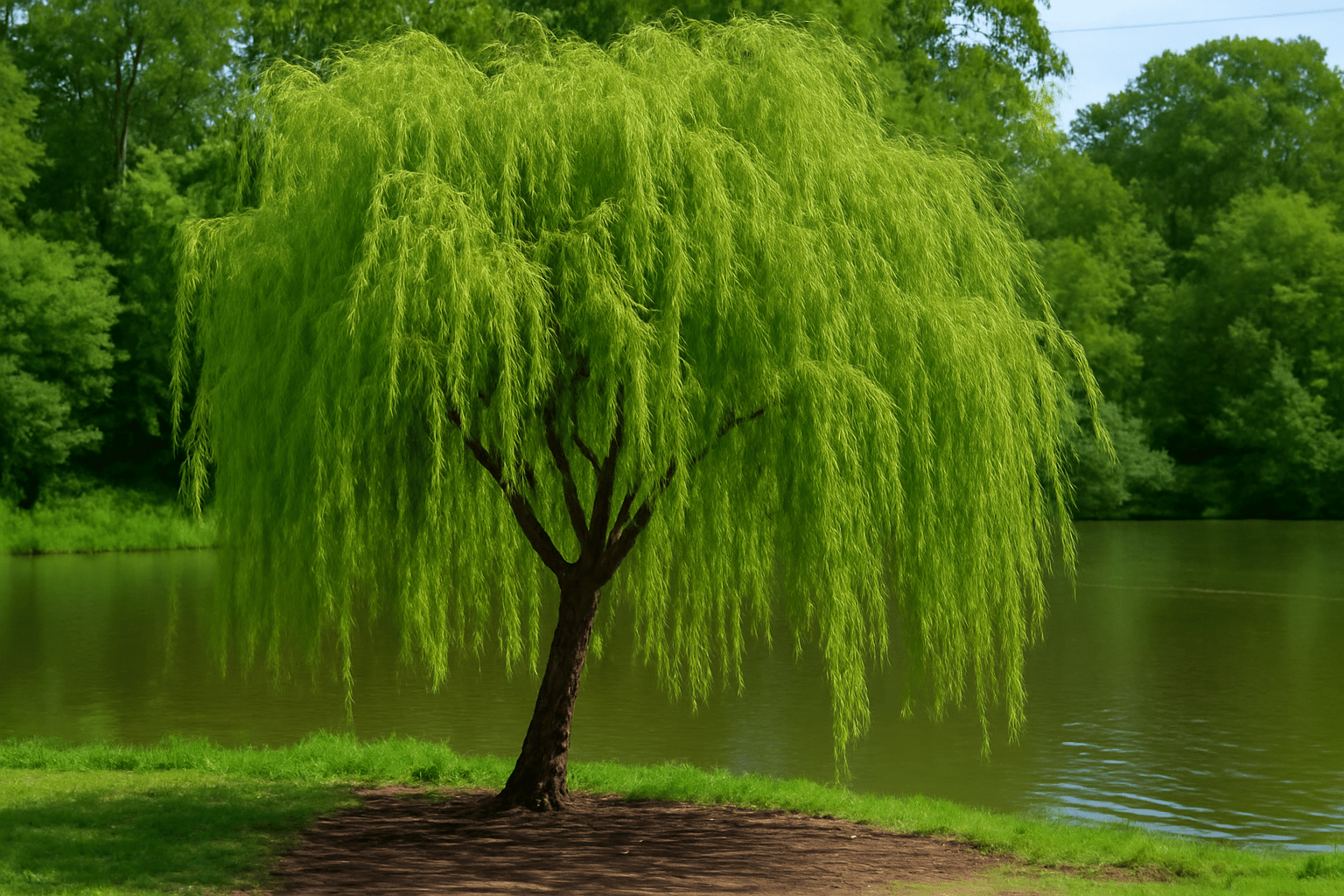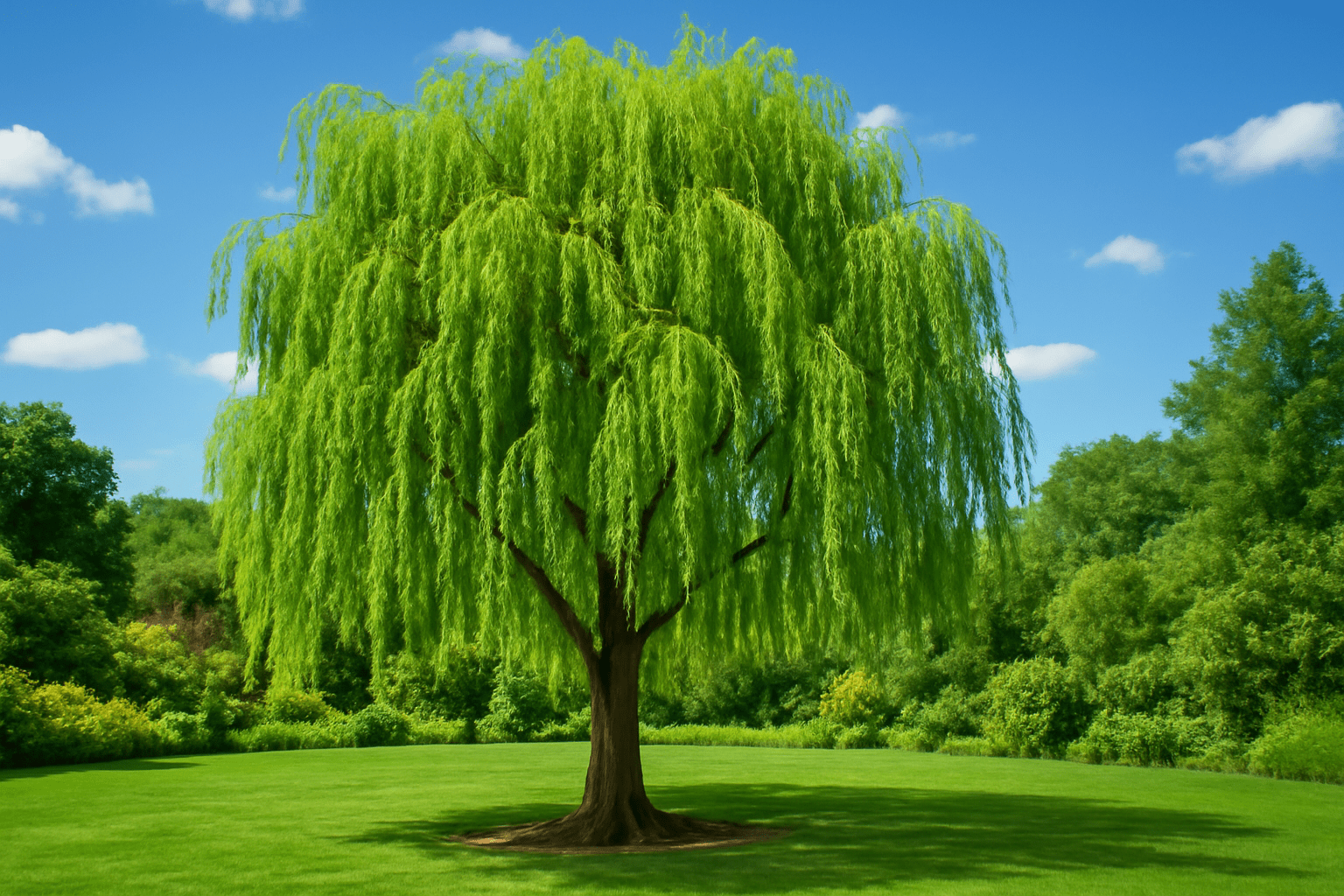
Understanding Weeping Willow Lifespan: How to Extend the Life of Your Tree
The weeping willow tree, with its elegant, cascading branches and soothing presence, is a favorite among gardeners and landscapers. 
In this guide, we’ll explore the average lifespan of a weeping willow tree and provide expert tips on how to extend its life. Whether you’re looking to plant one or already have one in your yard, knowing how to care for your weeping willow can make a world of difference. Keep reading to discover how you can help your tree grow strong and live longer!
Table of Contents
ToggleWhat is the Average Lifespan of a Weeping Willow Tree?
Weeping willows are stunning, graceful trees that can add beauty to any landscape. But how long can these majestic trees live? The average lifespan of a weeping willow tree is typically between 30 to 50 years. However, with the right care and conditions, some can live even longer.
Several factors influence how long your weeping willow will thrive:
- Growing Conditions: Willows prefer moist, well-drained soil and plenty of sunlight. Trees planted in these ideal conditions are more likely to live a full, healthy life.
- Maintenance: Regular pruning to remove dead branches and avoid disease can extend a willow’s life. Keep an eye out for pests and diseases that can shorten their lifespan.
- Climate: Weeping willows are best suited for temperate climates with plenty of rainfall. Extreme weather conditions, such as drought or harsh winters, can impact their longevity.
While their lifespan isn’t as long as some other trees, with the right care, your weeping willow can be a long-lasting, beautiful addition to your garden!
Factors That Affect Weeping Willow Lifespan
Weeping Willows are beautiful, graceful trees, but their lifespan can be influenced by several factors. Understanding these can help you keep your tree healthy and thriving for years. Here are some key aspects to consider:
1. Watering Needs 
Weeping Willows thrive near water sources like ponds or rivers. However, they need consistent watering, especially during dry spells. A lack of water can cause the tree to become stressed, which may shorten its lifespan. Ensure the soil is kept moist but not soggy, as too much water can lead to root rot.
2. Soil Quality 
The soil quality plays a significant role in a Weeping Willow’s health. Well-drained, fertile soil with a slightly acidic to neutral pH is ideal. Poor soil can lead to weak growth and vulnerability to pests and diseases. Make sure the tree is planted in nutrient-rich soil, and consider adding organic matter to improve soil health.
3. Pests and Diseases 
Like all trees, Weeping Willows can fall prey to various pests and diseases, such as willow borers, aphids, and fungal infections. Regularly inspect the tree for signs of trouble, such as discolored leaves, wilting, or holes in the bark. Addressing these issues early with appropriate treatments can prevent long-term damage.
4. Climate and Weather Conditions 
Weeping Willows are adaptable to different climates but do best in moderate temperatures with ample sunshine. Extreme weather conditions—like droughts, heavy winds, or prolonged cold—can stress the tree. Consider the climate of your area when planting your tree, and provide shelter from harsh winds if necessary.

5. Pruning and Maintenance 
Proper pruning helps maintain the tree’s shape and prevents overgrowth, which can stress the tree. Regularly remove dead or damaged branches to promote healthy growth. However, avoid heavy pruning, as this can weaken the tree and leave it susceptible to infections.
By keeping these factors in mind, you can ensure your Weeping Willow enjoys a long, healthy life. Simple maintenance and attention to its needs can make all the difference!
Common Problems That Affect Weeping Willow Lifespan
Weeping Willows are stunning trees, but like all plants, they can face challenges that shorten their lifespan. Let’s explore the most common problems that could affect the health of your tree and how to prevent them.
1. Overwatering or Poor Drainage 
Weeping Willows thrive near water, but they don’t like standing water around their roots. Too much water, especially in poorly drained soil, can lead to root rot. Symptoms include yellowing leaves and stunted growth. To avoid this, plant your willow in well-draining soil and ensure the area doesn’t stay soggy after rainfall.
2. Pest Infestations 
Willows are prone to certain pests, such as aphids, caterpillars, and borers. These pests can weaken the tree by feeding on the leaves and branches, leading to leaf drop and potential disease. Keep an eye out for insects and treat infestations early with eco-friendly insecticidal soap or natural predators like ladybugs.
3. Fungal Diseases 
Fungal infections such as willow rust and powdery mildew can damage the tree. These diseases can cause wilting, discolored leaves, and in severe cases, death. To prevent fungal problems, ensure good air circulation around your tree, avoid overhead watering, and prune any affected branches to reduce the spread.

4. Excessive Pruning 
While it’s important to prune your willow to maintain its shape, excessive pruning can stress the tree and reduce its lifespan. Always prune in moderation, removing only dead or diseased wood. It’s also best to do this during the dormant season to prevent unnecessary stress.
5. Environmental Stress 
Extreme weather conditions, such as drought or flooding, can put significant stress on a Weeping Willow. While the tree is naturally resilient, extended periods of heat, cold, or excessive flooding can damage it. Consider planting in a sheltered area and ensure it’s adequately watered during dry spells.
6. Soil Compaction 
Compacted soil can prevent roots from receiving enough oxygen, hindering growth and overall health. To help, aerate the soil around your tree periodically and avoid heavy foot traffic near the root zone.
Conclusion
By keeping an eye out for these common issues and addressing them promptly, you can extend the lifespan of your Weeping Willow and enjoy its graceful beauty for years to come. Remember, healthy trees begin with healthy practices!
How to Extend the Lifespan of Your Weeping Willow Tree
Weeping willows are beautiful, fast-growing trees, but like all plants, they need proper care to thrive for many years. Here’s how you can extend the lifespan of your weeping willow tree, ensuring it remains healthy and vibrant for decades to come:
1. Plant in the Right Spot 
Weeping willows love full sunlight, so make sure to plant yours in an area that gets at least 6 hours of direct sunlight daily. They also thrive near water sources, so choose a location with good drainage and moisture. Avoid planting near structures or other trees that may compete for resources.
2. Water Regularly 
Watering is key to your willow’s health. While these trees tolerate wet soils, they still need consistent moisture. Water your tree deeply during dry spells, especially in the summer months, to prevent the roots from drying out. However, avoid waterlogging, as it can lead to root rot.
3. Prune Wisely 
Regular pruning not only keeps your tree looking neat but also helps it grow strong. Remove dead or diseased branches, especially during the early spring or late fall. This will improve air circulation and reduce the risk of disease. Always use clean, sharp tools to prevent damage to the tree.

4. Mulch to Retain Moisture 
Applying a layer of mulch around the base of your tree can help retain moisture, regulate soil temperature, and reduce weed competition. Just be sure to leave a small gap around the trunk to avoid moisture buildup that can cause rot.
5. Fertilize Annually 
Feed your willow tree with a balanced fertilizer in early spring to encourage healthy growth. Use a slow-release formula to provide consistent nutrients throughout the growing season. Avoid over-fertilizing, as this can lead to weak growth and attract pests.
6. Monitor for Pests and Diseases 
Weeping willows are prone to certain pests like aphids and caterpillars, and diseases such as willow scab. Regularly inspect your tree for any signs of damage or infection. Early intervention can prevent the spread of issues. If necessary, treat with natural pesticides or consult a local arborist for advice.
7. Ensure Proper Support 
Due to their long, drooping branches, weeping willows can be vulnerable to wind damage. If you live in a windy area, consider staking your tree during its younger years to provide extra stability. As the tree matures, its roots will become stronger, offering better support.
By following these simple steps, you can significantly extend the lifespan of your weeping willow, ensuring it remains a stunning focal point in your garden for years to come!
How to Know if Your Weeping Willow Tree is Healthy 
A healthy Weeping Willow tree is a beautiful addition to your garden, but how can you tell if it’s thriving? By checking for a few key signs, you can ensure your tree stays vibrant and strong.
1. Healthy Leaves 
The leaves are a great indicator of your tree’s health. Healthy Weeping Willow leaves should be bright green, smooth, and elongated. If you notice yellowing or browning, it could be a sign of stress, such as overwatering, nutrient deficiency, or disease.

2. Proper Growth Pattern 
Weeping Willows are known for their graceful, drooping branches. If your tree is growing upright or unevenly, it might not be getting the proper care it needs. Regular pruning and attention to its surroundings can help maintain its signature weeping form.
3. Strong Bark and Branches 
Examine the bark for any cracks, peeling, or unusual discoloration. A healthy Weeping Willow will have firm bark that doesn’t peel excessively. Branches should also feel strong and flexible, not brittle. If branches break easily, this could indicate a weakened tree.
4. Vibrant Roots 
Roots should be firm and stable, holding the tree in place. If the soil around the tree feels overly soft or the tree leans significantly, it may be a sign that the root system is compromised. Ensure the tree is planted in well-draining soil to prevent root rot.
5. Pest and Disease Resistance 
Check for any signs of pests or diseases, such as webbing, spots, or mold. While some pests may be harmless, a large infestation can stress your tree. Regularly inspect your Weeping Willow to catch any issues early and treat them effectively.
By staying on top of these signs, you’ll keep your Weeping Willow looking lush and healthy for years to come!
Conclusion
Understanding the weeping willow lifespan and how to properly care for this stunning tree is key to ensuring it thrives for many years. With the right planting conditions, regular maintenance, and timely pest control, your weeping willow tree can grow strong, healthy, and beautiful. By following the expert tips shared in this guide, you can help your tree live a long and vibrant life, bringing charm and elegance to your landscape.

Start taking proactive steps today to extend the life of your weeping willow tree, and enjoy its graceful presence for seasons to come. 
Frequently Asked Questions(FAQ)
How long does it take for willow tree seeds to germinate?
Willow tree seeds typically germinate within 7 to 14 days, provided the conditions are right. Ensuring moist soil and proper temperature (around 65-70°F or 18-21°C) helps speed up the germination process.
Do willow tree seeds need stratification before planting?
Willow tree seeds don’t require a cold stratification process like some other tree species. However, soaking them in water for 12-24 hours before planting can improve their germination rate.
Can I grow willow tree seeds indoors?
Yes, you can start willow tree seeds indoors in containers. Use a well-draining potting mix, and make sure the seeds get plenty of sunlight, ideally 6-8 hours a day, for the best growth.
What’s the best time of year to plant willow tree seeds?
The best time to plant willow tree seeds is in early spring when the temperatures are mild. This allows the seeds to sprout as the weather warms, and the trees have time to establish roots before the heat of summer.
How much sunlight do willow tree seedlings need?
Willow tree seedlings need full sunlight to thrive. Aim for at least 6 hours of direct sunlight per day, especially during the early stages of growth, to encourage strong, healthy development.
How deep should I plant willow tree seeds?
Plant willow tree seeds about 1/4 to 1/2 inch deep in the soil. Gently press the soil down after planting to ensure good contact between the seed and the soil for better germination.
What type of soil is best for planting willow tree seeds?
Willow trees prefer moist, well-draining soil with a slightly acidic to neutral pH. Loamy or sandy soils work best, as they provide adequate drainage and prevent water from collecting around the roots.
Why are my willow tree seeds not germinating?
If your willow tree seeds aren’t germinating, it could be due to too dry soil, low temperatures, or insufficient sunlight. Ensure you are keeping the soil consistently moist, maintain ideal temperature levels, and provide enough light for the seeds to sprout.



